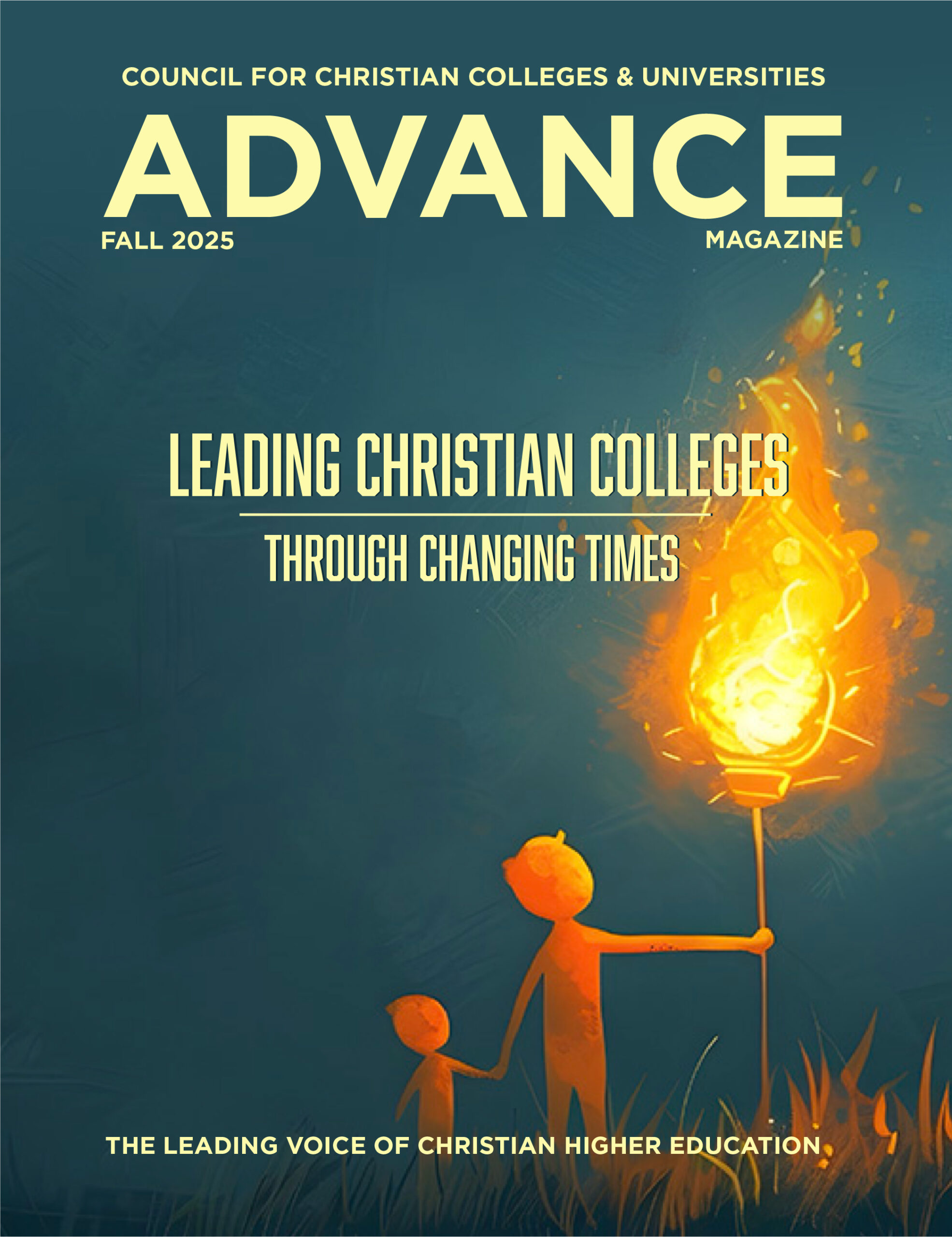Magazine

As a teacher—whether K-12 or a college professor—have you ever pondered questions like: What does it mean to teach in a Christianly manner? Or: Where is my calling in the teaching profession? Or: How can I develop a genuine faith-based imagination in my teaching?
Always Becoming, Never Arriving: Developing an Imagination for Teaching Christianly (Cascade Books, 2024), written by David J. Mulder, dives into these questions and offers valuable insight, while also reminding us that we are not necessarily supposed to ever arrive at any perfect answers to these challenging questions. As the title of the book makes clear, we are never arriving, but instead continuously making efforts to teach in ways that honor these questions through a Christian worldview. We are, in fact, always becoming.
Dr. Mulder, a professor and chair of the education department at Dordt University (Sioux Center, IA), writes in his introduction of the book, “Whether you are new to the profession or a seasoned veteran, you will find ideas to expand your imagination about what teaching Christianly looks like, considering topics that run the range from professionalism and ethics, to a biblical view of learners and learning, to content knowledge and curriculum, to planning, instruction, and assessment.”
Written to encourage Christian teachers—newly minted to greatly experienced—to bridge the gap between their faith and their teaching practices, the book emphasizes that teaching Christianly is not an end goal, but a continual journey of growth in both faith and pedagogy.
While I agree that any teacher—including college professors—can find something of value in Mulder’s book, I would add that it is primarily geared toward new teachers, alongside college students (or even high school students) who are considering studying education as a major.
For example, Chapter 7, titled, “Jesus Loves the Little Children: Learner Development,” trumpets the author’s affinity toward caring for God’s creation through His created children. Mulder builds on this idea in Chapter 8, “Jesus Loves ALL the Little Children: Learner Diversity,” which takes a deeper dive into the value and richness of cultural diversity and embracing those students who do not align with our concept of the “typical student.”
In this context, Mulder asks: “What is a typical kindergartener? A typical grade 3 student? A typical middle schooler? A typical senior in high school?” His point is that most students are anything but typical when we consider them as unique individuals created in the image of an almighty God.
In these two pivotal chapters, Mulder draws meaningful connections between the social science of anthropology—that is, the study of humans—and the theological context that examines the way people respond to each other in Christian faith and “express their spirituality in their day-to-day lives.” That is, he examines how we interact with our students, regardless of age, learning levels, backgrounds, and cultures, in a manner that glorifies God and recognizes that He created all of us in His image.
Each chapter of Dr. Mulder’s book opens with a personal “journal entry” from an imaginary teacher, called, “Taylor’s Journal,” which the author recommends reading before moving through the chapter.
Mulder makes the teacher gender-neutral so readers can place themselves into the fictional Taylor’s shoes, to “try and imagine what this teacher is feeling as you read those journal entries.” This empathetic posture draws from Mulder’s own experience as he earned his bachelor’s degree in elementary education (from then-Dordt College in 1998), his master’s in curriculum and instruction from the same institution in 2008, and a doctorate in educational technology from Boise State University in 2017. After teaching K-12, Mulder has been at Dordt University since 2006, conducting research, writing books and journal articles, presenting at various conferences, and, most importantly, teaching and mentoring our future teachers.
Mulder’s advice to read these conversationally toned journal entries prior to the rest of the chapter is worth heeding because these short opening passages remind the reader that his book is geared perhaps more specifically toward grade school teachers, as many of the entries discuss the lower grade levels.
Mulder, who has delivered over 100 professional development sessions for K-12 educators across North America, invites teachers to view each decision in the classroom—from content mastery assessment methods all the way down to how desks are arranged in a teacher’s classroom space—as faith-guided acts of biblical discipleship, Christian witness, and testimony. Advising readers to view teaching as a calling more than merely an occupation, Mulder aims to help readers “shrink the gap between what we (say we) believe and what we actually do in our teaching.”
Mulder explicates key themes in considering teaching as an act of discipleship, while always remaining creative in our imagination for “teaching Christianly.” As Mulder unpacks this concept throughout the book, he narrows in on exactly what he means by this in Chapter 14, “Effective Instruction: Teaching like Jesus?” and clearly points out in the following chapter that this effort is ongoing and never ending, titling Chapter 15, “Joy on the Journey: Why We Never ‘Arrive’ at Teaching Christianly.”
Relating those times when teachers tirelessly struggle to reach students to instances when Jesus faced some of the same relatable challenges, Mulder raises a refreshingly provocative question: Was Jesus an effective teacher? After all, scripture tells us that many of Jesus’ parabolic messages were met with confusion. The Bible references numerous occasions in which his disciples completely missed the message he was trying to convey.
Mulder’s response brings encouragement to any teacher, K-12, college or otherwise, who has made intentional strategic efforts to bring strong pedagogy into the classroom only to be met with confused looks, apathy, or boredom. “Here’s the truth,” Mulder says. “In our work as teachers, we don’t always see immediate success. Some of our work is planting seeds—seeds that may sprout and bear fruit much later on,” as was so often the case with the parables and teachings of Jesus.
As we try out new and various approaches to getting through to our students, what Mulder calls “pedagogical moves,” the questions that must remain central to the process are, “What am I doing?” and “Why am I doing this?” These ever-relevant questions serve as affirmation connecting to the very core of the book, from which its title is derived, that we are never completely arriving at the perfect lesson plan, but we are always striving to develop our own personal interpretation of what it means to display effective Christian pedagogy. We are always becoming.
And as long as we maintain a Christian approach to our work in the classroom, or office, or workplace in general, then we are always moving in the right direction. Chapter 15 adds to this sentiment and explains in greater detail the reason why we never actually arrive at teaching Christianly. Mulder notes, “Our journey to more fully living out our faith as Christians who teach is a life-long endeavor.”
Examples that Mulder points out of “teaching Christianly” include devotional activities, modeling Christlike behaviors, infusing a Christian perspective, doing service projects, maintaining rigor and discipline, evangelism, and imitating Christ as the “Master Teacher.”
Approaching our work as teachers through a faith-informed lens enables us to expand our imagination, moving our ideal of teaching Christianly from theory to practice.
Ultimately, Always Becoming, Never Arriving is less a manual and more a companion for the long, challenging, and rewarding road of teaching. It reminds us that the work of education is never finished—that both teachers and students are always growing, always becoming.
For anyone seeking to bring faith and purpose into the classroom, this book offers wisdom that is both practical and deeply rooted in scripture. It left me grateful for my own calling in higher education, and even more appreciative of the faithful K-12 educators who daily embody the very truths Mulder so thoughtfully describes.
His encouragement and biblical insights underscore the weight, responsibility, and privilege of shaping students’ lives through sound Christianly pedagogy. In the end, Mulder’s vision is a timely reminder that teaching is not about reaching a finish line but about faithfully walking with students as we are continually formed in Christ.
Dr. C. Allin Means is associate dean for the School of Communications at Missouri Baptist University, in St. Louis, and professor of journalism and communications. He joined the MBU faculty in 2011 after teaching at Baylor University, the University of Southern Mississippi (where he earned his doctorate degree in communications), Southeastern Oklahoma State University, Morris College and Northwest Florida State College. A member of the National Scholars Honor Society, Dr. Means earned the Emerson Excellence in Teaching Award in 2021 and the Distinguished Professor of the Year Award from MBU in 2017.
__________
Do you know of a recent or upcoming book that is relevant to Christian higher education? Share your book review suggestions with us by sending an email to editor@cccu.org.

